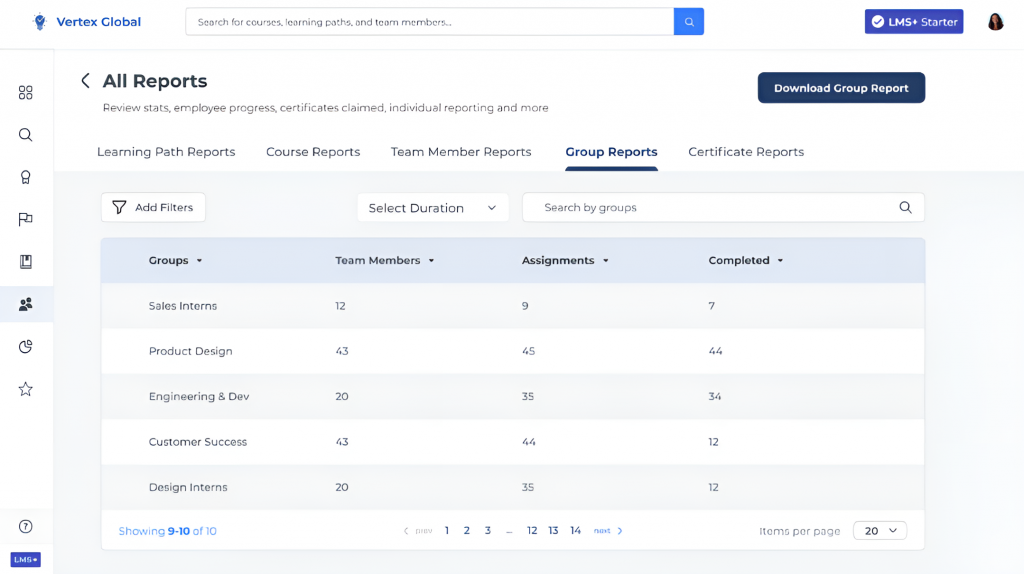Every learner leaves a digital trail. The challenge is deriving insight from it. Data has become the backbone of every high-performing L&D strategy. But here’s THE PROBLEM: the sheer volume of learning data can be overwhelming. Sifting through spreadsheets, reconciling reports, and trying to piece together progress across hundreds of learners isn’t just time-consuming; it can actually slow down your decision-making.
Instead of looking at learner performance in isolation, what if you could zoom out and assess how whole teams, departments, or cohorts are progressing? This is precisely what grouped data enables you to do. It is the smarter, faster, and more actionable way to track and monitor staff training.
Let’s break down why grouped data is essential for modern L&D.
Track Team Progress Without Spreadsheets
Reporting becomes very simple when your learners are organised into groups, whether by team, role, location, or project.
Grouped data allows you to:
- View team-level performance metrics at a glance
- Compare progress across departments
- Monitor who’s compliant and who isn’t
- Instantly identify laggard behaviour, and take action
And the best part? You can do all this without manually building reports from scratch.
According to Watershed LRS, 60% of L&D managers now face executive pressure to measure the impact of learning, a significant increase from previous figures. This highlights the growing emphasis on demonstrating the tangible outcomes of L&D efforts in corporate settings.
Pro tip: Use group trends to forecast training needs for the next quarter. Seeing a dip in completion rates for a certain team? Schedule a quick sync with their manager to understand blockers and re-align on priorities. Then, adjust learning paths to stay on track with business goals.
The corporate digital learning sector has experienced significant growth, expanding from $86.78 billion in 2018 to a projected $153.41 billion by 2028, marking a 77% increase. This surge has led to an abundance of learning data, making it challenging for L&D professionals to sift through and derive actionable insights. Traditional methods of analysing individual learner data are often time-consuming and may not provide a holistic view of organisational learning trends.
(Source: Intuition)
Understanding Grouped Data Analytics
Grouped data analytics involves organising learners into specific cohorts such as teams, departments, or roles and analysing their collective learning behaviors and outcomes. This approach shifts the focus from individual performance to group dynamics, enabling L&D professionals to identify patterns, trends, and areas for improvement more efficiently.
The strategic advantages
- Enhanced tracking and reporting: By analysing data at the group level, organisations can monitor progress, completion rates, and engagement metrics more effectively. This streamlined approach reduces the complexity associated with individual data analysis.
- Identifying trends and insights: Grouped data allows you to recognise learning patterns across different teams or departments, facilitating targeted interventions and resource allocation.
- Spotting skill gaps: Analysing group performance can reveal specific skill deficiencies within teams, enabling the development of tailored training programmes to address these gaps.
- Recognising top performers: Group analytics can highlight high-performing teams or individuals within cohorts, providing opportunities for recognition and the sharing of best practices.
- Reducing administrative workload: By focusing on group data, L&D professionals can streamline reporting processes, allowing more time for strategic planning and programme development.
How Organisations Use Grouped Data to Drive Strategic L&D Decisions
Data alone doesn’t create change – insights do. Grouped learning data helps connect the dots between learning outcomes and business performance. When looking at trends by team, department, or region, you can make informed decisions about everything from course design to budget allocation.
Here’s how organisations are using grouped analytics to steer their L&D strategy:
- Resource planning: See which departments are falling behind on compliance or lagging in soft skills and redirect training efforts accordingly.
- Budget allocation: Invest more in high-performing groups that show strong learning engagement and ROI, while using insights to rework underperforming programmes.
- Curriculum adjustments: Spot common drop-off points or low engagement in specific content modules across groups and fine-tune your curriculum design based on real evidence.
- Leadership development: Use group analytics to identify emerging leaders across teams by combining learning data with performance metrics, then nurture that talent intentionally.
L&D becomes a strategic advisor to the business, seeing the bigger picture. Every team-level data tells a story.
How To Implement Grouped Data Analytics in Your L&D Strategy
To effectively integrate grouped data analytics into your L&D strategy, consider the following steps:
- Define clear objectives: Establish what you aim to achieve with grouped data analytics. Whether it’s improving course completion rates, identifying skill gaps, or enhancing engagement, clear objectives will guide your analysis.
- Organise learners into meaningful groups: Segment your learners based on relevant criteria such as job function, department, location, or experience level. This grouping should align with your organisational structure and learning objectives.
- Utilise advanced analytics tools: Leverage Learning Management Systems (LMS) and analytics platforms that support grouped data analysis. These tools can automate data collection, visualisation, and reporting, making it easier to derive insights.
- Monitor and evaluate group performance: Regularly assess the performance of different groups to identify trends, challenges, and opportunities. This ongoing evaluation enables proactive adjustments to your L&D programmes.
- Foster a culture of continuous improvement: Use the insights gained from grouped data analytics to foster a culture of continuous learning and improvement. Encourage teams to collaborate, share knowledge, and support each other’s development.
Actionable Tips
You’ve got the tools. Now make the most of them. Here are some practical ways L&D leaders are maximising the impact of grouped learning data in their workflows:
- Tag your groups smartly: Go beyond department names and create learning groups based on goals (e.g., “Future Managers 2025” or “Client-Facing Teams – APAC”). This allows for more meaningful insights and inspires participants.
- Use baseline comparisons: Before launching a new training initiative, capture group-level metrics like average assessment scores or completion rates. Then compare post-training data to measure real impact.
- Layer data with qualitative feedback: Group trends are powerful, but pairing them with feedback surveys helps explain the “why” behind the numbers.
- Set benchmarks between groups: Establish internal benchmarks like average time to complete a training path or engagement scores so teams can constructively track their performance against others.
- Make it visual: Use dashboards and charts to present grouped data in a way that’s easy for stakeholders to understand. A visual overview often sparks faster decisions.
- Keep it dynamic: Don’t treat groups as static. Update them as teams change, new projects launch, or skills needs shift. Dynamic grouping keeps your data meaningful.
Grouped Data becomes a powerful lever to optimise learning, prove impact, and influence business outcomes.
Now, Let Your Data Work For You
As someone in L&D, what you need is clarity. Confidence. The ability to say, “Here’s what’s working, here’s what’s not, and here’s what we’re doing next.”
That’s what grouped data gives you.
You don’t need to overhaul your entire system to get there. Set up a quick demo to see how Alison LMS and grouped analytics can help you.
If you are already subscribed to Alison’s LMS+,
- Log in to your LMS dashboard and explore the Groups menu
- Schedule a demo to see how it works in action
- Or reach out to our team for help setting it up










